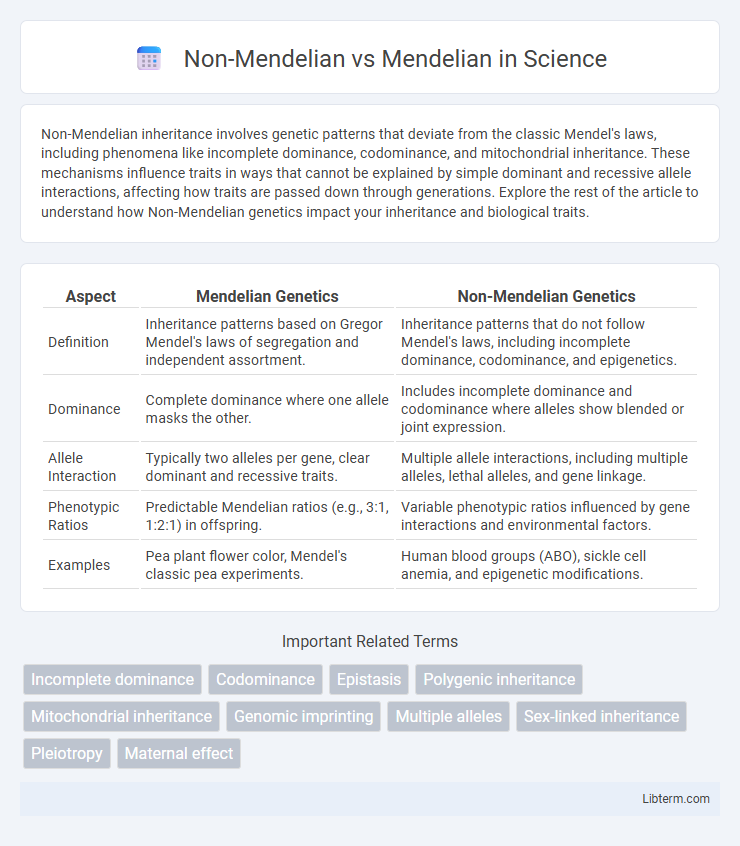Non-Mendelian inheritance involves genetic patterns that deviate from the classic Mendel's laws, including phenomena like incomplete dominance, codominance, and mitochondrial inheritance. These mechanisms influence traits in ways that cannot be explained by simple dominant and recessive allele interactions, affecting how traits are passed down through generations. Explore the rest of the article to understand how Non-Mendelian genetics impact your inheritance and biological traits.
Table of Comparison
| Aspect | Mendelian Genetics | Non-Mendelian Genetics |
|---|---|---|
| Definition | Inheritance patterns based on Gregor Mendel's laws of segregation and independent assortment. | Inheritance patterns that do not follow Mendel's laws, including incomplete dominance, codominance, and epigenetics. |
| Dominance | Complete dominance where one allele masks the other. | Includes incomplete dominance and codominance where alleles show blended or joint expression. |
| Allele Interaction | Typically two alleles per gene, clear dominant and recessive traits. | Multiple allele interactions, including multiple alleles, lethal alleles, and gene linkage. |
| Phenotypic Ratios | Predictable Mendelian ratios (e.g., 3:1, 1:2:1) in offspring. | Variable phenotypic ratios influenced by gene interactions and environmental factors. |
| Examples | Pea plant flower color, Mendel's classic pea experiments. | Human blood groups (ABO), sickle cell anemia, and epigenetic modifications. |
Introduction to Inheritance Patterns
Mendelian inheritance follows strict patterns of dominant and recessive allele transmission as established by Gregor Mendel's laws, involving traits controlled by single genes. Non-Mendelian inheritance encompasses various complex genetic phenomena such as incomplete dominance, codominance, multiple alleles, and mitochondrial inheritance that deviate from classic Mendelian ratios. Understanding these inheritance patterns is crucial for exploring genetic diversity, predicting trait outcomes, and studying diseases influenced by multiple genes or non-nuclear DNA.
Defining Mendelian Inheritance
Mendelian inheritance refers to the genetic principles first described by Gregor Mendel, where traits are determined by single genes with clear dominant or recessive alleles, resulting in predictable phenotypic ratios. Non-Mendelian inheritance encompasses genetic patterns that do not follow these simple rules, including incomplete dominance, codominance, multiple alleles, and polygenic inheritance. Understanding Mendelian inheritance provides a foundation for studying genetic traits that follow straightforward patterns of transmission through generations.
Overview of Non-Mendelian Inheritance
Non-Mendelian inheritance encompasses genetic patterns that deviate from the classic Mendelian laws of segregation and independent assortment, involving phenomena such as incomplete dominance, codominance, mitochondrial inheritance, and epigenetic modifications. These inheritance patterns often result in phenotypic ratios that do not align with simple dominant-recessive relationships, highlighting the complexity of genetic expression and transmission. Understanding non-Mendelian mechanisms is crucial for comprehending traits influenced by multiple genes, environmental factors, or non-nuclear DNA, as seen in mitochondrial diseases and epigenetic disorders.
Key Differences Between Mendelian and Non-Mendelian Inheritance
Mendelian inheritance follows predictable patterns based on dominant and recessive alleles, as described by Gregor Mendel's laws of segregation and independent assortment. Non-Mendelian inheritance includes inheritance patterns such as incomplete dominance, codominance, mitochondrial inheritance, and polygenic traits, where multiple genes influence a phenotype or traits do not segregate in simple dominant-recessive manners. Key differences include the predictability of offspring phenotypes in Mendelian traits versus the complex, variable expression seen in non-Mendelian inheritance, often involving multiple alleles, gene interactions, or extranuclear DNA.
Classic Examples of Mendelian Genetics
Classic examples of Mendelian genetics include traits like pea plant flower color, seed shape, and human blood types, which follow predictable dominant and recessive inheritance patterns. Gregor Mendel's experiments with Pisum sativum demonstrated how alleles segregate independently, establishing foundational laws such as the Law of Segregation and the Law of Independent Assortment. These Mendelian traits contrast with non-Mendelian inheritance patterns, where factors like incomplete dominance, codominance, and mitochondrial DNA influence genetic outcomes beyond simple dominant-recessive relationships.
Major Types of Non-Mendelian Inheritance
Non-Mendelian inheritance encompasses patterns such as incomplete dominance, codominance, mitochondrial inheritance, and genomic imprinting, each diverging from classical Mendelian ratios. In incomplete dominance, heterozygotes express an intermediate phenotype, while codominance involves the simultaneous expression of both alleles, exemplified by AB blood type. Mitochondrial inheritance transmits traits exclusively through maternal lineage, and genomic imprinting results in gene expression dependent on the parent of origin, challenging Mendel's principles of independent assortment and dominance.
Genetic Disorders: Mendelian vs Non-Mendelian
Genetic disorders classified as Mendelian follow predictable inheritance patterns such as autosomal dominant, autosomal recessive, or X-linked traits driven by single-gene mutations like cystic fibrosis or Huntington's disease. Non-Mendelian genetic disorders involve complex inheritance mechanisms, including mitochondrial inheritance, genomic imprinting, or multigenic contributions, often seen in diseases like mitochondrial myopathies and certain cancers. Understanding the distinction aids in accurate diagnosis, risk assessment, and personalized treatment strategies by focusing on gene expression and mutation interplay beyond classic Mendelian ratios.
Molecular Basis of Inheritance Variations
Non-Mendelian inheritance encompasses molecular mechanisms such as mitochondrial DNA transmission, genomic imprinting, and gene interactions like epistasis, which deviate from classical Mendelian segregation patterns. Mendelian inheritance relies on the segregation and independent assortment of alleles located on nuclear chromosomes, following predictable dominant-recessive relationships. Variations in the molecular basis of inheritance involve epigenetic modifications, extranuclear DNA, and polygenic effects, expanding the understanding of genetic trait expression beyond Mendel's original laws.
Relevance of Inheritance Patterns in Modern Genetics
Non-Mendelian inheritance patterns, such as codominance, incomplete dominance, mitochondrial inheritance, and epigenetics, expand the understanding of genetic variation beyond classical Mendelian ratios. These patterns reveal the complexity of gene expression and inheritance, crucial for modern genetics research, including genetic disorders, personalized medicine, and evolutionary biology. Recognizing both Mendelian and Non-Mendelian mechanisms allows for accurate genetic prediction and targeted therapeutic strategies in contemporary medical genetics.
Future Directions in Genetic Research and Inheritance
Non-Mendelian inheritance, involving mechanisms like epigenetics, mitochondrial DNA, and gene interactions, is expanding the understanding of genetic complexity beyond traditional Mendelian laws. Future directions in genetic research emphasize integrating multi-omics data and advanced computational models to unravel polygenic traits and environmental influences on gene expression. These innovations promise to enhance precision medicine, enabling tailored therapies based on an individual's unique genetic and epigenetic profiles.
Non-Mendelian Infographic

 libterm.com
libterm.com